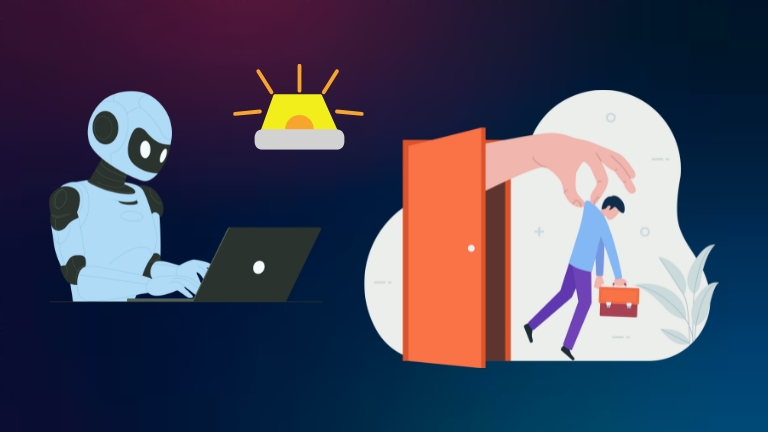Maria, a mid-level data analyst at a logistics firm in Texas, was let go. Not because of performance issues or company losses, but because her tasks were quietly automated by an AI tool her team had been testing. She didn’t see it coming. And she’s not alone.
The march of artificial intelligence into the workplace has shifted from theory to reality. From software engineers to content creators, many roles that once felt secure are now being reconsidered or restructured. This article explores the 2025 landscape of job displacement caused by AI, offering a data-backed view into how this technology is changing employment dynamics across industries.
Editor’s Choice
- 8.2 million jobs are estimated to have been lost globally due to AI automation by mid-2025.
- The United States accounts for approximately 1.4 million of these displaced roles in 2025, the highest for any single country.
- Manufacturing saw the most disruption, with over 510,000 US jobs automated in 2025 alone.
- 52% of Fortune 500 companies reported AI-led workforce restructuring initiatives in Q1 2025.
- 82% of large enterprises in the US implemented AI tools that directly reduced headcount as of June 2025.
- Retail and customer service sectors reported a 33% decline in human staffing needs year-over-year in 2025.
- A record 18% of Gen Z workers in tech-related fields were impacted by AI-induced job loss as of April 2025.
AI’s Disruptive Impact on Jobs and the Workforce
- AI could replace up to 300 million full-time jobs globally, a staggering projection that underscores the transformative force of automation.
- In marketing and advertising, 37% of professionals have already embraced generative AI, showcasing rapid adoption in creative industries.
- 14% of workers say they’ve been replaced by robots or automation, revealing the real-life consequences of tech-driven labor shifts.
- A strong 77% of companies are either using or planning to use AI, signaling a major shift toward AI-driven operations across sectors.
- In just May 2023, the US recorded 3,900 job losses tied directly to AI, a clear sign that workforce disruption is no longer theoretical.
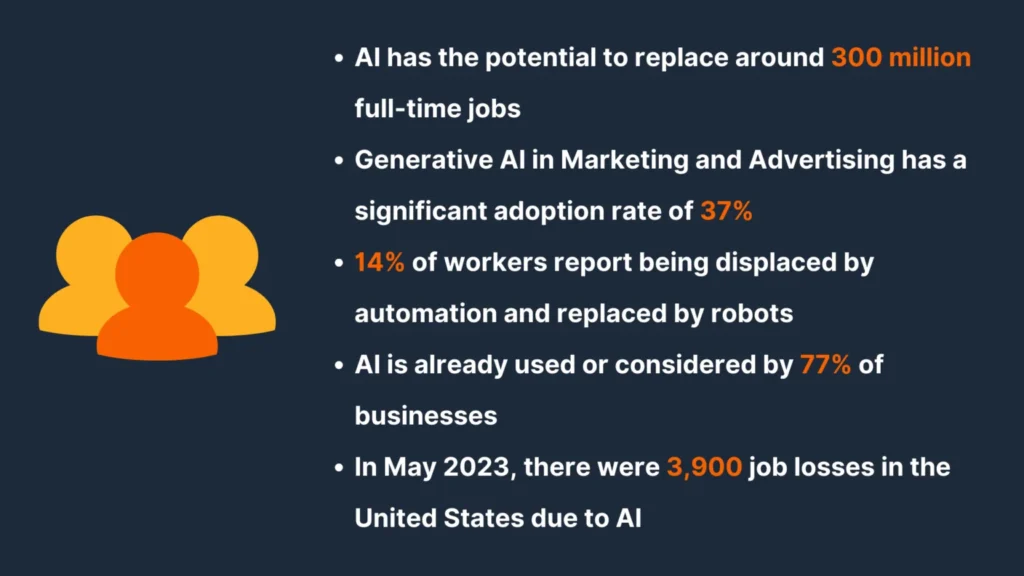
Rise in Redundancies Linked to AI Integration
- By Q2 2025, 41% of companies with over 1,000 employees had initiated layoffs linked to AI systems.
- Financial services firms reported a 21% reduction in back-office roles due to AI integration.
- In 2025, 39% of HR departments used AI to manage recruitment, onboarding, and even terminations.
- Customer support bots replaced approximately 185,000 call center jobs in the US during the first half of 2025.
- Healthcare administration roles saw a 15.5% reduction as electronic record automation expanded in 2025.
- Among surveyed mid-sized companies, 64% indicated that AI had made at least one department redundant by May 2025.
- Asia-Pacific firms led in redundancy actions, accounting for 34% of all reported AI-linked layoffs globally in 2025.
- Legal research automation displaced 12,000 junior attorney and paralegal positions in the US in the first quarter of 2025.
- 45% of executives cited “AI efficiency” as the primary reason for workforce restructuring in their 2025 corporate filings.
- The average time between AI deployment and related job cuts was 4.3 months as of 2025 data.
AI’s Role in Reshaping Employment Landscapes
- 92% of business leaders in the US acknowledged that AI adoption has permanently changed at least one core job function by 2025.
- The role of data entry clerks is projected to shrink by 44% in 2025.
- AI-driven analytics platforms replaced at least 38% of manual reporting tasks in US corporations by mid-2025.
- Hybrid roles, blending AI management with traditional job duties, increased by 57% across all industries in 2025.
- Remote work coupled with AI tools led to 19% fewer in-house IT support positions in 2025.
- The need for real-time human decision-making declined sharply in logistics, leading to a 29% drop in dispatcher roles in 2025.
- AI writing assistants replaced or reduced human input in 41% of content marketing departments across Fortune 1000 firms by Q1 2025.
- Education tech platforms that integrate adaptive AI reduced the need for human tutors by 18% globally in 2025.
- In urban planning, AI simulation tools replaced 22% of junior analyst roles in municipal governments by 2025.
- Despite losses, 34% of employers reported reassigning staff to AI oversight roles.
AI Job Replacement Risk by Industry
- Administration roles top the list, with 26% of jobs at risk. Tasks like data entry and clerical work are highly automatable.
- Customer service comes next, with 20% of positions vulnerable. AI chatbots and assistants are rapidly transforming how companies handle inquiries.
- 13% of production jobs face replacement risk, especially in manufacturing, where automation and robotics are becoming the norm.
- The legal field sees a 6% risk, as AI tools support research and document review, yet human reasoning remains essential.
- In education, only 5% of jobs are at risk. AI can support teaching, but human interaction is still core to learning.
- Creative and artistic careers show a 4% risk. While AI can assist with content, it lacks originality and emotional nuance.
- Management roles are the least affected, with just a 3% risk. Leadership and complex decision-making still depend on people.
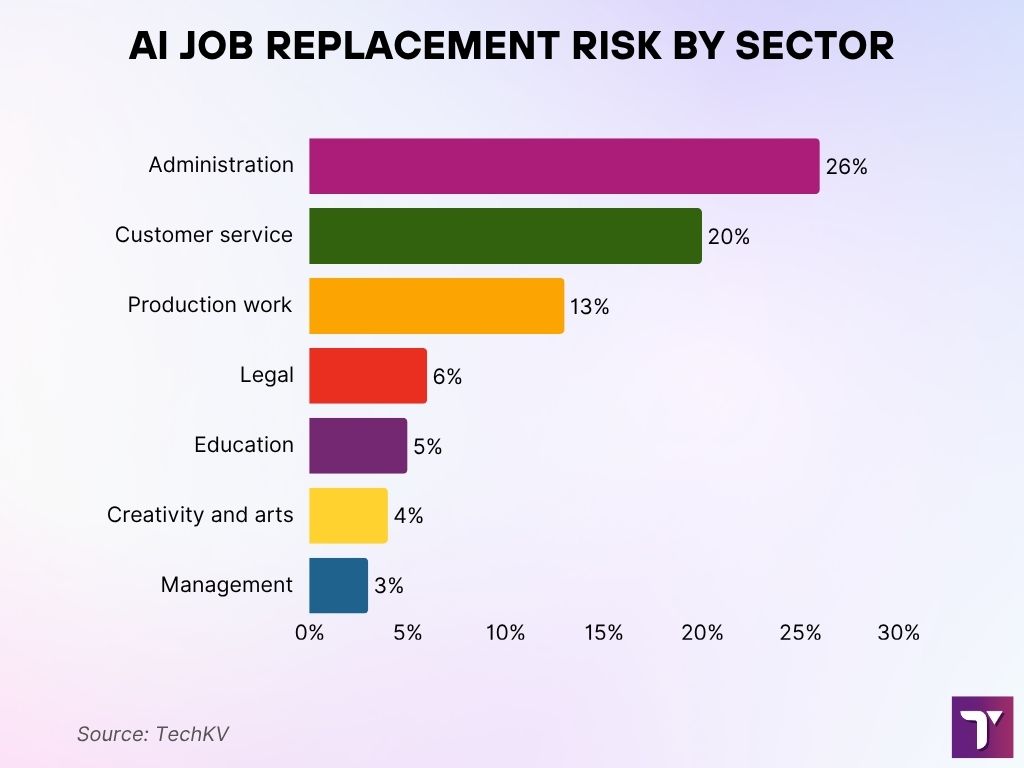
Key Industries Reporting Workforce Downsizing from AI
- Manufacturing topped the list with 510,000 US jobs lost due to automation by mid-2025.
- The retail sector experienced the second-highest AI-driven layoffs, with 310,000 roles affected in 2025.
- Transportation and warehousing saw a 21% automation rate, translating to 230,000 eliminated positions in 2025.
- The financial sector reported downsizing of 92,000 jobs linked to AI-based fraud detection and risk analysis tools in 2025.
- Education services saw a 12.5% cut in human instructors at private tutoring firms using adaptive learning AI in 2025.
- Media and publishing lost an estimated 35,000 content creation jobs to generative AI tools in 2025.
- The legal sector experienced a 9% workforce reduction among junior roles due to document review AI in 2025.
- Real estate firms using AI for lead scoring and outreach cut their sales teams by 22% in 2025.
- Insurance underwriting saw 17,000 roles made redundant through AI prediction models in 2025.
- Pharmaceutical companies used AI for R&D and downsized 8,000 research associate positions by mid-2025.
Statistical Trends in Layoffs Attributed to AI Technologies
- In 2025, 31% of job layoffs across major US firms were explicitly tied to AI implementation.
- The average department headcount reduction per AI initiative was 12.4% in 2025, compared to 8.7% a year earlier.
- AI-powered automation impacted 43% of business services roles, including administrative support, in 2025.
- A cross-industry survey showed that 60% of organizations experienced headcount shifts within 6 months of deploying AI tools in 2025.
- Retail banking reported a 29% job displacement rate among tellers and customer advisors in 2025, as AI chatbots handled more inquiries.
- HR tech platforms using AI for pre-screening led to the elimination of 11,000 recruiter roles across the US in 2025.
- AI in logistics helped reduce dispatch staffing by 37%, primarily through predictive routing tools in 2025.
- Digital advertising firms eliminated 15,200 analyst jobs in 2025, relying on automated A/B testing and AI campaign optimization.
- 19% of AI-induced layoffs in 2025 occurred within companies under 500 employees, highlighting its reach beyond large enterprises.
- 47% of C-level executives reported using AI outcome metrics as part of restructuring decisions in 2025.
Firsthand Encounters with AI-Driven Job Loss
- A significant 79% of people say they haven’t been personally affected by AI-related job cuts, nor do they know anyone who has.
- 11% admit they’ve personally lost a job because of AI, highlighting a growing minority feeling the direct impact.
- Another 10% say someone they know has faced job loss due to AI, pointing to a rising awareness of AI’s reach in the workforce.
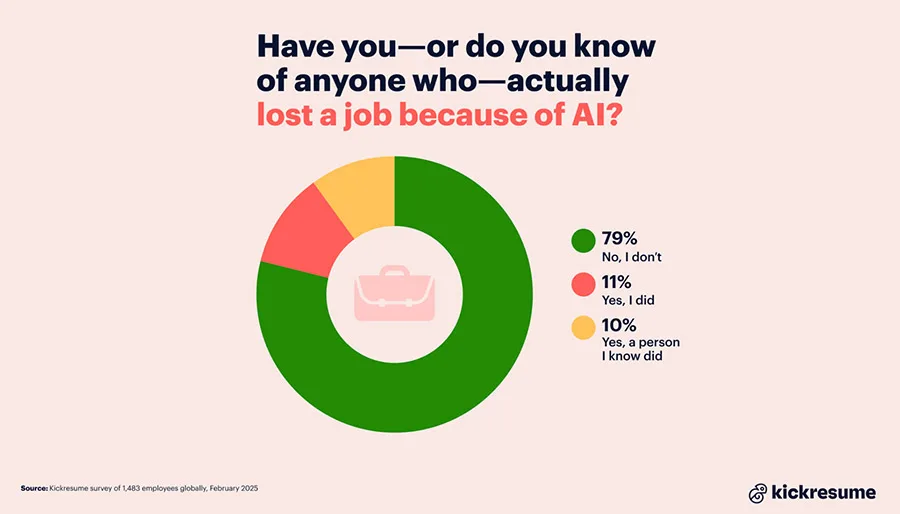
Impact of AI on Freelancers and Gig Economy Workers
- Freelance job postings for roles like content writing, virtual assistance, and transcription declined by 35% on major platforms in 2025.
- Platforms like Upwork and Fiverr saw a 22% increase in AI-assisted gigs (e.g., prompt engineering, AI audit), replacing traditional freelance tasks.
- Voiceover freelancers experienced a 40% decrease in bookings in 2025, largely due to the widespread use of AI voice synthesis.
- Design freelancers faced a 28% drop in paid work as AI-based tools like image generators became commonplace in 2025.
- Gig delivery jobs were down 15% in urban areas as AI-optimized autonomous delivery pilots scaled up during 2025.
- Translation services saw a 33% demand reduction due to real-time AI translation tools adopted by global SaaS providers in 2025.
- Remote freelancing opportunities in data labeling plummeted by 42% in 2025 as large models became increasingly self-supervised.
- AI-generated music tools displaced work for composers and audio engineers, with 11% fewer freelance project listings in 2025.
- Gig platforms that offered AI-powered service matchmaking eliminated about 6% of human customer support roles in 2025.
- 91% of freelancers surveyed in 2025 reported that clients either reduced project scope or budget due to AI adoption.
Union Responses to AI-Induced Workforce Reductions
- In 2025, 68% of labor unions in the US flagged AI as a “top risk factor” in their collective bargaining priorities.
- The UAW strike in Q1 2025 included AI deployment clauses, marking the first major labor action targeting AI-related layoffs.
- 32,000 workers in tech and publishing unions joined advocacy efforts to regulate AI job replacement protocols in 2025.
- New AI-protection agreements were signed in 17 states, setting limits on layoffs without prior human reassessment in 2025.
- 56% of unionized workplaces implemented AI impact assessment committees by May 2025.
- Labor organizations successfully delayed AI rollouts in 23% of proposed cases in manufacturing hubs in 2025.
- AI transparency mandates were included in new contracts for over 120,000 union workers in service and retail by mid-2025.
- Teachers’ unions in 13 states demanded mandatory human oversight for AI-driven grading systems in 2025.
- In Canada and the US, cross-border unions formed an AI Rights Coalition, expanding influence on legislative proposals by Q2 2025.
- 49% of surveyed union reps believed current federal protections against AI layoffs remain “insufficient” as of June 2025.
Public Opinion on AI Replacing Human Jobs in 50 Years
- 50% of respondents say AI will probably take over most human jobs within the next five decades, a sign of growing expectation.
- 15% are more certain, believing AI will definitely replace a large share of human labor in that timeframe.
- 25% lean toward skepticism, saying AI will probably not replace most jobs, showing hesitation about long-term disruption.
- Just 7% are fully confident AI will definitely not replace significant human work, representing a small but firm minority.
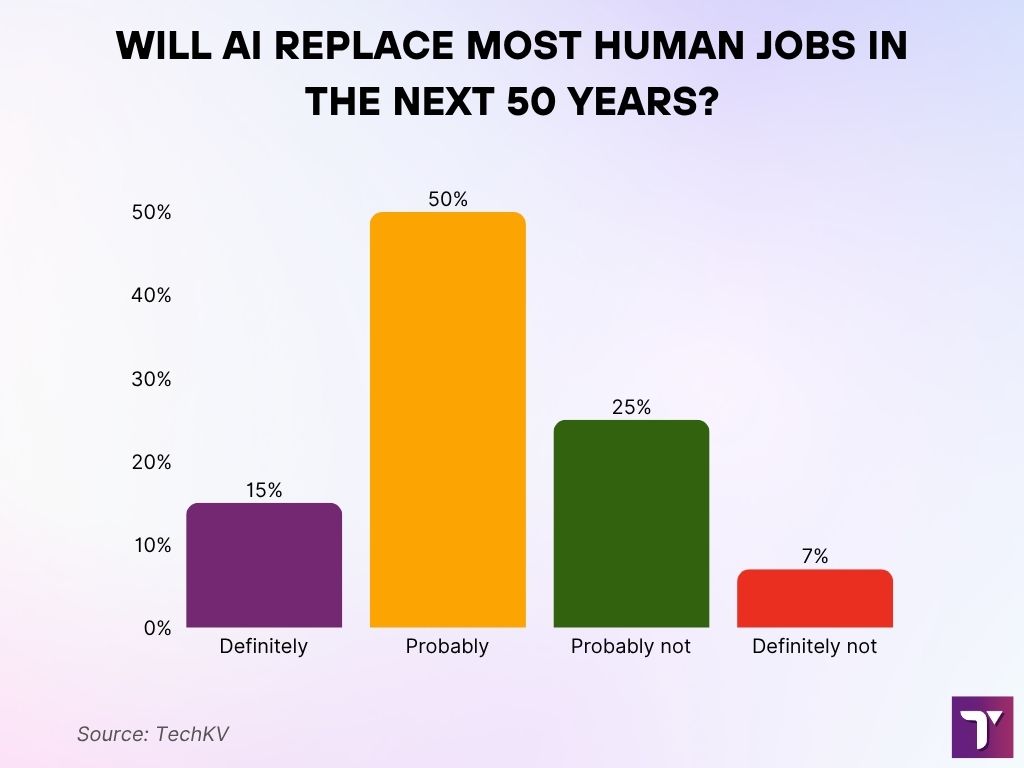
Startups and Small Business Job Losses Tied to AI Adoption
- 35% of US-based startups with under 100 employees reported staff reductions due to AI integration in 2025
- AI-based accounting tools led to job losses in 48% of small accounting firms surveyed in 2025.
- Small e-commerce brands using automated inventory and pricing systems cut operations staff by 27% in 2025.
- CRM automation tools resulted in the removal of 15% of entry-level sales roles across early-stage B2B firms in 2025.
- AI-based website builders reduced demand for contract web developers by 31% among small design agencies in 2025.
- The top five startup-friendly AI tools used in 2025, Zapier AI, Jasper, Copilot, QuickBooks AI, and ChatGPT, collectively displaced over 110,000 jobs.
- Legal tech startups cut 12% of staff working in document prep as AI workflows became standard in 2025.
- 23% of SBA loan recipients in 2025 disclosed that AI tools reduced their projected hiring needs.
- Digital marketing agencies with under 50 staff reported downsizing content production teams by 33% due to AI generators in 2025.
- AI-driven scheduling tools eliminated roles in virtual assistant startups, shrinking workforce size by 18% year-over-year in 2025.
AI-Driven Job Loss in Developing vs Developed Countries
- In developed economies, job automation accounted for 2.6% of total employment shifts in 2025, compared to 0.9% in developing economies.
- India saw approximately 270,000 white-collar roles, mostly in tech support and finance, displaced due to AI in 2025.
- Sub-Saharan Africa reported minimal direct job loss, but 17% of employers noted future risks from imported AI platforms in 2025.
- Latin America experienced a 14% decrease in data entry and transcription jobs in 2025, with AI adoption accelerating in call centers.
- In Japan, AI-led automation drove down roles in logistics and retail by 3.2% in 2025, disproportionately affecting senior workers.
- Germany and France initiated subsidies in 2025 to reskill 100,000+ workers affected by AI deployment in public sector roles.
- The Philippines’ BPO industry lost 11.4% of its full-time workforce in 2025, primarily due to AI integration by multinational clients.
- US tech offshoring to developing nations slowed in 2025 as companies retained AI-managed workflows locally, reducing reliance on overseas labor.
- South Korea implemented AI offset taxes in 2025 to cushion layoffs in the manufacturing and telecom sectors.
- Nigeria and Kenya began testing AI-led government services in 2025, but with careful controls to avoid abrupt staff dismissals.
Countries Most at Risk of Job Loss from Automation by 2030
- China leads the projection with a massive 47.8% of jobs at risk from automation, by far the largest expected impact globally.
- India is next, with 24.3% of jobs potentially affected, pointing to rapid automation adoption in its growing economy.
- The United States could see 14.8% of roles displaced, reflecting a significant shift even among developed nations.
- Japan, despite its tech-savvy workforce, may lose 6.1% of jobs to automation by 2030.
- Mexico faces a smaller impact, with 3.6% of jobs at risk, while Germany comes in slightly lower at 3.4%, suggesting milder disruption in these regions.
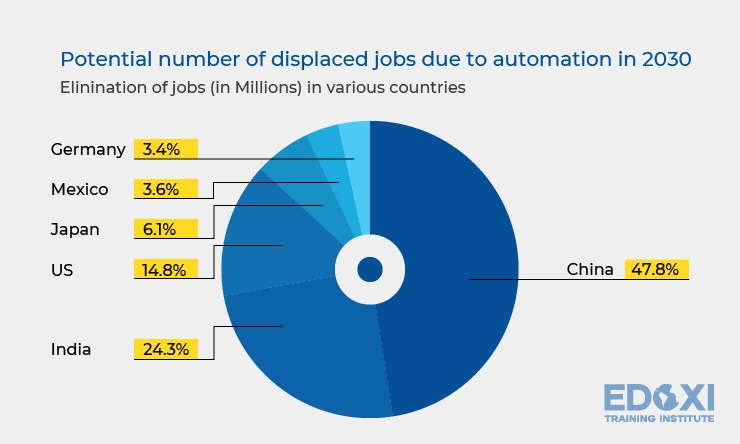
Skill Gaps and Their Role in AI-Related Job Cuts
- 61% of layoffs in tech and operations roles in 2025 were attributed to a lack of AI-related upskilling.
- Workers without AI fluency were 2.3x more likely to be impacted by job cuts in 2025, according to national HR datasets.
- 43% of laid-off employees in 2025 had not received any AI-specific training or cross-skilling in the previous two years.
- Entry-level roles requiring no AI competency dropped by 38% in availability in 2025.
- Despite widespread AI adoption, only 27% of employers offered reskilling programs focused on automation-resistant skills in 2025.
- Among manufacturing workers, 72% of AI-related job losses occurred in plants that had no formal digital training in place by 2025.
- In the finance sector, positions involving repetitive analysis saw a 31% cut in 2025, while roles involving AI tool fluency grew by 19%.
- Women were disproportionately affected in administrative AI layoffs in 2025, with 56% citing skill gaps as the primary reason for dismissal.
- Community college programs saw a 47% enrollment increase in AI and automation courses in the first half of 2025, indicating a response gap.
- Soft skills, like critical thinking and human-AI collaboration, were named by 74% of recruiters as must-haves in new job listings by mid-2025.
Case Studies of Companies Cutting Jobs Due to AI
- Retail giant Walcart laid off 3,200 warehouse workers in Q1 2025 after implementing autonomous sorting bots.
- FinBank, a US-based financial institution, replaced 680 financial analysts with AI portfolio management software in 2025.
- QuickType Media eliminated 75% of its copywriting team in April 2025 after adopting generative content tools.
- GreenHaul Logistics transitioned to AI routing and fulfillment in 2025, removing 500+ dispatch roles in North America.
- Tradia Legal, a B2B legal tech firm, announced a 50% reduction in paralegal staff due to its new AI-powered document analysis platform in 2025.
- Helix Health Systems deployed predictive diagnostics AI in early 2025, resulting in a 22% reduction in junior clinical support roles.
- ZentroTech, a SaaS automation company, closed entire QA divisions at two offices after shifting to AI test environments in 2025.
- EduSys, a major edtech provider, removed 400 tutor support roles after full deployment of adaptive learning bots in 2025.
- AirNova Airlines introduced AI scheduling software in March 2025, eliminating 120 coordination roles across its US network.
- ShopSwift, a fashion e-retailer, replaced 90% of its customer support team with generative AI bots in Q2 of 2025.
What People Think About AI’s Effect on Jobs
- 47% of respondents are optimistic, believing AI will create more jobs than it replaces, hopeful for a tech-driven job boom.
- 26% take a more pessimistic view, expecting AI to eliminate more jobs than it creates, pointing to rising fears of disruption.
- Another 26% say it’s too early to predict, reflecting widespread uncertainty about AI’s long-term role in the labor market.
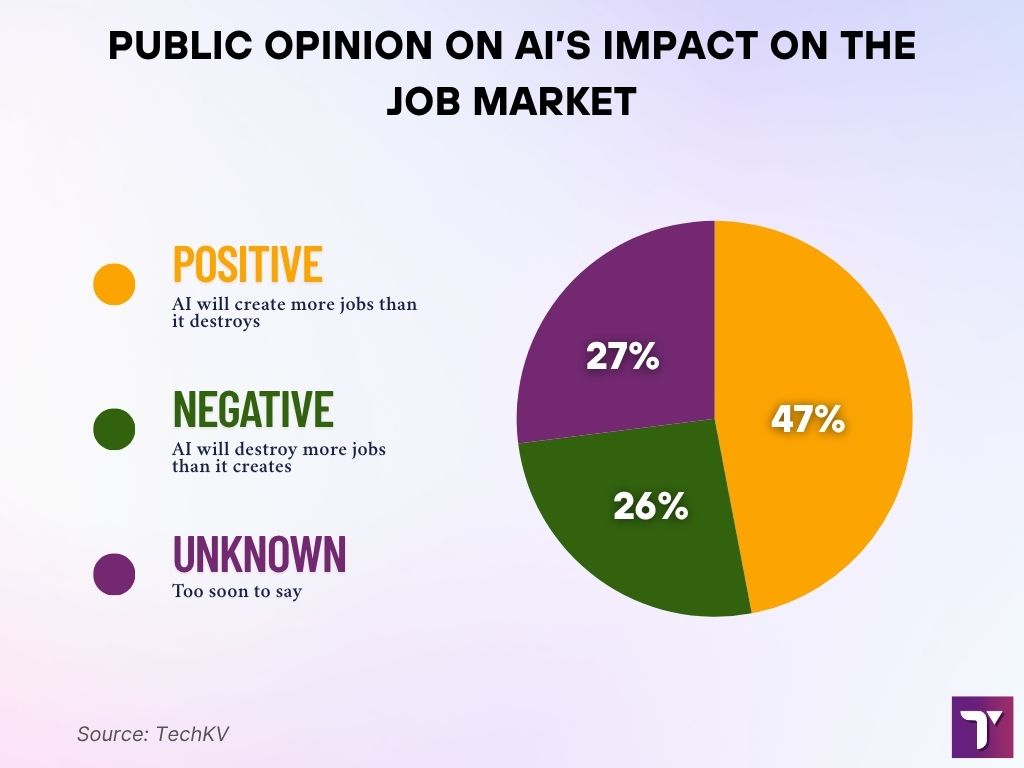
Forecast Models Estimating AI Job Disruption Rates
- By the end of 2025, forecast models estimate up to 11 million global jobs will be displaced by AI.
- In the US, AI-related disruptions are projected to affect 6.4% of the total workforce by early 2026.
- The World Economic Forum projects that 44% of job skills will shift by 2027, driven primarily by AI, with a steep rise starting in 2025.
- Automation probability modeling from MIT estimates that 47% of current US job tasks are now partially or fully automatable in 2025.
- AI disruption is expected to plateau around 2030, but 2025–2026 are projected to be the steepest curve years for displacement.
- High-risk roles (e.g., data entry, basic finance, telesales) are predicted to shrink by 48% cumulatively between 2023 and 2026, with 2025 as the peak contraction point.
- A study by Brookings found that 82% of layoffs in automation-prone roles in 2025 occurred without simultaneous job creation in new departments.
- McKinsey’s model forecasts that AI will replace 400,000 jobs in the US tech sector alone between 2025–2027, with 160,000 of those in 2025.
- The employment elasticity to AI deployment turned negative in 2025, indicating that job losses outpaced the rate of job transformation.
- The average AI displacement rate across industries reached 2.8% per quarter in 2025.
Recent Developments
- In July 2025, the US Department of Labor proposed new reporting rules requiring companies to disclose AI’s impact on job reductions.
- Major enterprise platforms like Salesforce and Microsoft launched new AI governance dashboards in 2025 to monitor HR impact and ethical compliance.
- California passed a bill in Q2 2025 requiring companies to provide a 90-day notice before conducting AI-driven layoffs.
- AI certifications gained traction, with Coursera and Udemy reporting 68% more enrollments in professional retraining by mid-2025.
- In May 2025, a bipartisan proposal for an AI Worker Transition Fund entered the US Senate for discussion.
- New York launched the AI Layoff Assistance Program (AILAP) in June 2025, offering support and reskilling vouchers to impacted workers.
- LinkedIn’s AI job filter, introduced in 2025, now lets users identify roles least likely to be disrupted by automation.
- Multiple universities partnered with industry leaders in 2025 to offer AI ethics and employment risk modules in business and tech programs.
- The European Union expanded its AI Liability Directive in 2025, requiring transparency in automated employment decisions.
- Amazon unveiled a “Human-in-the-Loop” initiative in 2025, integrating ethical review into its AI deployment processes across fulfillment centers.
Conclusion
As we look back at 2025, it’s clear that the AI revolution has matured, and with it, the realities of economic displacement have become impossible to ignore. While AI continues to unlock efficiency and scale, it has also ushered in a wave of disruption that workers and policymakers are scrambling to understand.
Job loss, however, is only one piece of the puzzle. There is also an opportunity: in new roles, hybrid skills, and smarter systems that still need human oversight. Whether that opportunity is made accessible to all depends on how companies, educators, and governments act next.
Navigating this shift requires not just statistics but empathy, foresight, and agility.
